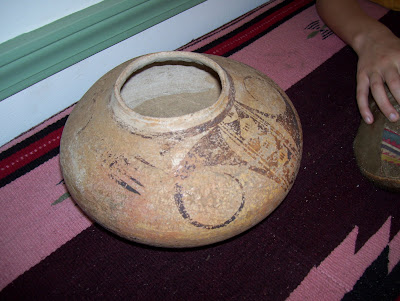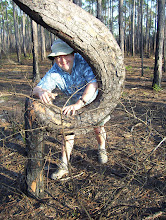 Last Saturday afternoon, after a brief return to Rico Community Center following our morning at Pickett's Mill Battlefield, we visited Civil War sites closer to home. The photo above is, well, basically the heart of downtown Palmetto, Georgia. This was our second stop of the afternoon -- to be nonlinear for a change, I will give it top billing, which probably has not happened before, beyond a couple of local newspaper articles on the occasion of monument dedications, maybe. It is an odd bit of ground for a memorial, situated on a patch of grass next to the unoccupied former train station and the still-busy railroad tracks, bounded on the opposite side by Main Street. The markers here are varied and eclectic. A Daughters of the Confederacy white obelisk from the early 1900s commemorates local units in the "War Between the States"; a roadside sign (shown above) recognizes the Confederate Army of Tennessee, stationed here for a few days shortly after the fall of Atlanta in 1864; a random cannon of no clear vintage (but certainly newer than the Civil War) sits beyond the sign, aimed not-so-menacingly at cars stopped at the traffic light; beyond the cannon is the relocated grave of William Menafee, the man who provided the land where the town now stands (or rather, slumps). I find it fitting, somehow, that the one who gave land to the town got a small plot back, for his own personal and rather long-term use.
Last Saturday afternoon, after a brief return to Rico Community Center following our morning at Pickett's Mill Battlefield, we visited Civil War sites closer to home. The photo above is, well, basically the heart of downtown Palmetto, Georgia. This was our second stop of the afternoon -- to be nonlinear for a change, I will give it top billing, which probably has not happened before, beyond a couple of local newspaper articles on the occasion of monument dedications, maybe. It is an odd bit of ground for a memorial, situated on a patch of grass next to the unoccupied former train station and the still-busy railroad tracks, bounded on the opposite side by Main Street. The markers here are varied and eclectic. A Daughters of the Confederacy white obelisk from the early 1900s commemorates local units in the "War Between the States"; a roadside sign (shown above) recognizes the Confederate Army of Tennessee, stationed here for a few days shortly after the fall of Atlanta in 1864; a random cannon of no clear vintage (but certainly newer than the Civil War) sits beyond the sign, aimed not-so-menacingly at cars stopped at the traffic light; beyond the cannon is the relocated grave of William Menafee, the man who provided the land where the town now stands (or rather, slumps). I find it fitting, somehow, that the one who gave land to the town got a small plot back, for his own personal and rather long-term use. The above photograph is of the law office of Jim Barfield in Palmetto, formerly the Stagecoach Inn, circa 1831. Jim proudly notes on his website (http://www.jimbarfield.com/, the source of the lovely out-of-season photograph above) that his office is the oldest commercial building in the whole of Fulton County, though he has only owned it himself for a scant fifteen years. Jim very kindly invited me to allow our Sense of Place Workshop group to tour his office, for which I am very grateful. Our afternoon outing began with a stop here. We admired his fine antiques inside, including a beautiful piece of Creek pottery, shown below. For all that Menafee might have given up his land for the town, it was the Creek's land for far longer than it was his, until McIntosh signed a piece of paper selling the land to the United States -- the Treaty of Indian Springs.
The above photograph is of the law office of Jim Barfield in Palmetto, formerly the Stagecoach Inn, circa 1831. Jim proudly notes on his website (http://www.jimbarfield.com/, the source of the lovely out-of-season photograph above) that his office is the oldest commercial building in the whole of Fulton County, though he has only owned it himself for a scant fifteen years. Jim very kindly invited me to allow our Sense of Place Workshop group to tour his office, for which I am very grateful. Our afternoon outing began with a stop here. We admired his fine antiques inside, including a beautiful piece of Creek pottery, shown below. For all that Menafee might have given up his land for the town, it was the Creek's land for far longer than it was his, until McIntosh signed a piece of paper selling the land to the United States -- the Treaty of Indian Springs. But all that was last month -- ancient history. This month is all about how Palmetto became contested terrain a second time, as the Union and Confederacy vied for victory. No major battles were fought here, but the former train station (the one before the one standing there now) was burned by McCook's Federal cavalry, who also tore up and burned the railroad tracks over a two-mile stretch in Palmetto in late June of 1864. Of course, the story of the sacking of the town and destruction of its rail line, connecting Atlanta with Columbus, is a tale told in the absence of evidence, since everywhere was "a scene of fire, of ruin, and devastation" (as quoted in Sherman's Horsemen by David Evans (Bloomington: Indiana University Press, p. 227). So Keith pointed to the current railroad underpasses (the arches with crumbling white plaster) and remarked that the raiders had burned the previous wooden trestles that once stood there, along with the town's original buildings (now gone) and the original rail line (since replaced). All that remains is an anachronistic cannon, like some sort of lawn ornament, a roadside plaque, and local stories.
But all that was last month -- ancient history. This month is all about how Palmetto became contested terrain a second time, as the Union and Confederacy vied for victory. No major battles were fought here, but the former train station (the one before the one standing there now) was burned by McCook's Federal cavalry, who also tore up and burned the railroad tracks over a two-mile stretch in Palmetto in late June of 1864. Of course, the story of the sacking of the town and destruction of its rail line, connecting Atlanta with Columbus, is a tale told in the absence of evidence, since everywhere was "a scene of fire, of ruin, and devastation" (as quoted in Sherman's Horsemen by David Evans (Bloomington: Indiana University Press, p. 227). So Keith pointed to the current railroad underpasses (the arches with crumbling white plaster) and remarked that the raiders had burned the previous wooden trestles that once stood there, along with the town's original buildings (now gone) and the original rail line (since replaced). All that remains is an anachronistic cannon, like some sort of lawn ornament, a roadside plaque, and local stories.
Back to Jim Barfield's law office. Lots of antiques, but nothing original to the mid-nineteenth century, besides the building itself, with its pine floors with incredibly wide floorboards, the kind that are very hard to come-by nowadays. Upstairs, most of the walls in the two rooms were never painted, and I have read that former occupants of the original tavern left their names on the wood, though I have never seen any. Downstairs, a swinging half-door with chipped gray paint once led to the Confederate post-office, operated out of the building during the war. Mostly what remains are stories. Supposedly, a very important meeting took place in the building, between General Hood and his staff and President Jefferson Davis, who also visited the town after the Battle of Atlanta. In that fateful meeting, which could well have happened there (it was, after all, one of the few available spaces when McCook got through with Palmetto's downtown) or could have happened in a military tent, or possibly elsewhere -- it was at that meeting that General Hood proposed to move north, to cut off Sherman's own rail lines supplying Atlanta. Jefferson Davis, gaunt and weary, approved. A grim miscalucation, to which Sherman responded by burning Atlanta and marching southeast, to the sea.
Leaving Jim Barfield's office, we paused along the brick walkway to notice the sunken stones that were once used by visitors to the stagecoach stop to mount and dismount from their coaches. Slowly, the stones are slipping away, subsiding into the ground. They are apt metaphors for Palmetto history -- so much is hidden, kept in attics or elder residents' memories, and slipping away. Or it is overlooked, intentionally forgotten, like accounts of horrible lynchings that occurred in Palmetto at the turn of the last century, decades after the war had ended -- but that, too, is another story, one difficult to tell.


No comments:
Post a Comment